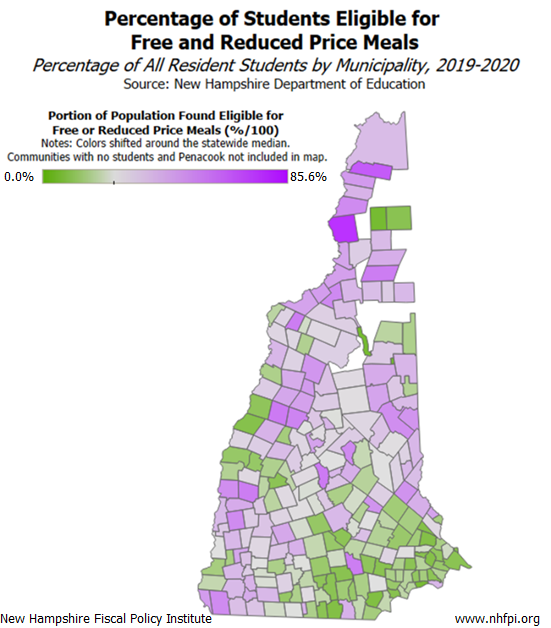Many New Hampshire students from households with low incomes are food insecure and depend on access to free or reduced-price meals at school. These meals are provided through a combination of federal, state, and local programs designed to reduce food insecurity. With New Hampshire schools closed at least through April 3 in response to the COVID-19 crisis, programs to provide pick-up and delivered meals will help, but some students and their families may experience reduced access to this important source of nutrition.
In October 2019, about one in every four New Hampshire students in grades one through 12 were eligible for free and reduced-price school lunches. Children are eligible for free and reduced-price school lunches if their household incomes are below 185 percent of the federal poverty threshold. In 2020, that income level translates to $31,894 for a family of two, or $40,182 for a family of three. In New Hampshire, students are also eligible if anyone in the household is enrolled in the New Hampshire Food Stamp Program (the federal Supplemental Nutrition Assistance Program, or SNAP) or the Financial Assistance for Needy Families program (the federal Temporary Assistance for Needy Families program, or TANF), or if the applicant is a foster child.
Prior to the onset of this crisis, an estimated 41,800 households in New Hampshire were food insecure. The job losses and reduced incomes likely accompanying the COVID-19 crisis, especially in industries with limited paid sick leave, will likely increase the overall level of food insecurity, which is already more prevalent for those with lower incomes.
If access to free and reduced-price school meals declines, certain families and communities may be impacted particularly severely, as some communities have higher levels of program enrollment. Data for resident students at the municipal level help guide state education funding, and are slightly older data than those reported at the individual school and district levels. These data show that there were communities across the state where more than 50 percent of students were eligible. These communities ranged from cities, including Berlin, Claremont, Laconia, and Manchester, to rural towns, such as Groton, Ossipee, Stratford, Winchester, and Woodstock. High levels of eligibility suggest these communities may have limited means to offer support to children and families locally.
Both the state and federal governments have taken actions to help ensure students continue to have access to meals while out of school. The New Hampshire Department of Education sought three waivers from the United States Department of Agriculture (USDA), which is the federal agency charged with administering these child nutrition programs, to permit meal pickups, employ summer meal programs while schools are closed, and provide reimbursable meals through sponsors. The USDA has issued one waiver to New Hampshire and three nationwide waivers to permit serving food outside of congregate settings, providing afterschool snacks or meals outside of a program or supervised environment, and feeding students outside of usual meal time requirements.
While schools have broad authority to provide meals to students in a manner that limits exposure to the 2019 novel coronavirus, the mechanisms for getting meals to students require community action with limited resources. School districts have been making impressive efforts, including deliveries by volunteers and school bus drivers, to get meals to students. Continuing, coordinating, and resourcing these efforts will be key to helping ensure that more students do not become food insecure as the COVID-19 crisis continues.
– Phil Sletten, Policy Analyst

